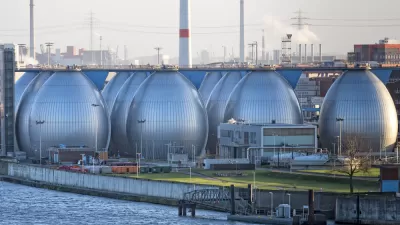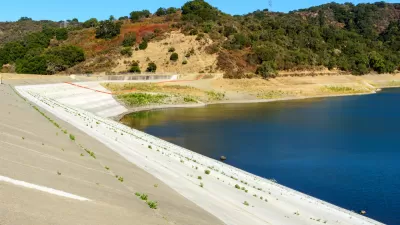The Wall Street Journal examines desalination efforts on the Central and South Coasts, starting with the reactivation of a Santa Barbara plant. Notwithstanding criticisms on costs and environmental damage, eight plants have been built since 2006.
The effects of California's drought are far-reaching on agriculture and urban areas alike. "With its local reservoirs at less than 30% of capacity, the City Council voted in September to pursue reopening the facility, which can turn sea water into the equal of nearly three-fourths of Santa Barbara’s normal demand for drinkable water," writes Jim Carlton.
"The City constructed the reverse osmosis seawater desalination facility as an emergency water supply in response to the severe drought from 1986 to 1991," according to the city's website. "Due to sufficient freshwater supplies since 1991, the facility remains in long-term standby mode for reactivation within two years."
Desalination technology does not come without critics, as one might expect, who "contend the costs are excessive given how little water the plants produce," writes Carlton. "It would take putting a plant every 2 to 3 miles in Southern California to equal what we get from the mountains,” said Conner Everts, co-chairman of the Desal Response Group, a nonprofit in Santa Monica, Calif.
“We think it’s the stupidest, most environmentally harmful water alternative possible,” said Kira Redmond, executive director of Channelkeeper, an environmental group in Santa Barbara.
According to their fact sheet [PDF], "Many desalination plants (including Santa Barbara’s) use screened intake pipes to draw seawater into the facility. Fish and other marine life are injured or killed when they become trapped or 'impinged' on the intake screens by the suction power of the intake."
Criticism notwithstanding, "(a)s of 2013, there were 26 desalination plants in California—up from 18 in 2006, according to the most recent data," writes Carlton. "Some are operated by government authorities while others are privately run."
Poseidon Water, a Boston company that develops water systems, is using $1 billion in private financing to construct a desalination plant in Carlsbad, Calif. It aims to provide the San Diego County Water Authority with about 8% of its water, at a cost up to twice that of water the agency imports from northern California.
Carlton describes facilities being planned or operating in Cambria, the Monterey Peninsula, and Huntington Beach. According to The Cambrian, "Sand City in Monterey County, Avalon on Catalina Island and Orange County are the only other communities in the state that regularly use desalinated water."
As noted in a post last April on Texas infrastructure, the "San Antonio Water System board took action (March 4) to begin what could become the nation's largest inland desalination plant," funded in part with a $109 million loan from the state, according to San Antonio Express-News. [They do everything bigger in Texas?].
FULL STORY: California Turns to the Ocean for Drinking Water

Study: Maui’s Plan to Convert Vacation Rentals to Long-Term Housing Could Cause Nearly $1 Billion Economic Loss
The plan would reduce visitor accommodation by 25,% resulting in 1,900 jobs lost.

North Texas Transit Leaders Tout Benefits of TOD for Growing Region
At a summit focused on transit-oriented development, policymakers discussed how North Texas’ expanded light rail system can serve as a tool for economic growth.

Why Should We Subsidize Public Transportation?
Many public transit agencies face financial stress due to rising costs, declining fare revenue, and declining subsidies. Transit advocates must provide a strong business case for increasing public transit funding.

How to Make US Trains Faster
Changes to boarding platforms and a switch to electric trains could improve U.S. passenger rail service without the added cost of high-speed rail.

Columbia’s Revitalized ‘Loop’ Is a Hub for Local Entrepreneurs
A focus on small businesses is helping a commercial corridor in Columbia, Missouri thrive.

Invasive Insect Threatens Minnesota’s Ash Forests
The Emerald Ash Borer is a rapidly spreading invasive pest threatening Minnesota’s ash trees, and homeowners are encouraged to plant diverse replacement species, avoid moving ash firewood, and monitor for signs of infestation.
Urban Design for Planners 1: Software Tools
This six-course series explores essential urban design concepts using open source software and equips planners with the tools they need to participate fully in the urban design process.
Planning for Universal Design
Learn the tools for implementing Universal Design in planning regulations.
City of Santa Clarita
Ascent Environmental
Institute for Housing and Urban Development Studies (IHS)
City of Grandview
Harvard GSD Executive Education
Toledo-Lucas County Plan Commissions
Salt Lake City
NYU Wagner Graduate School of Public Service




























